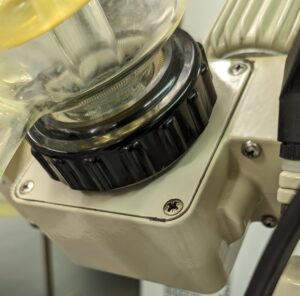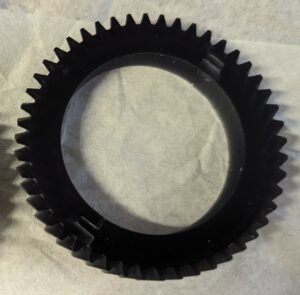 A rotary evaporator (RotaVap) is a core piece of equipment for any lab that does chemical synthesis, and Buchi make some of the best ones. Unfortunately, ours is about 25 years old and they no longer make parts for it.
A rotary evaporator (RotaVap) is a core piece of equipment for any lab that does chemical synthesis, and Buchi make some of the best ones. Unfortunately, ours is about 25 years old and they no longer make parts for it.
In the heart of the apparatus there’s a worm-drive… the motor is connected to a helical spindle which drives a ring gear. This is what spins the round-bottomed flask.
Over the past few months we’d been noticing that at low spin speeds, the rotation would skip. It would intermittently speed up and slow down through the rotation cycle. So, we opened up the gearbox to see what was inside (note – you may need to use a hammer to get the parts to separate out).
The problem is, Buchi decided to make the gear out of plastic, and years of exposure to grease and chemicals causes the plastic to crack, as shown here…
 The result is the motor spins but the plastic rung just grinds around and doesn’t spin the metal part that’s eventually attached to the flask. The worm gear is basically slipping once per rotation. We tried buying a used model off eBay, and upon dissection it had exactly the same problem, so it appears this is a common fault on this particular model (RE-111).
The result is the motor spins but the plastic rung just grinds around and doesn’t spin the metal part that’s eventually attached to the flask. The worm gear is basically slipping once per rotation. We tried buying a used model off eBay, and upon dissection it had exactly the same problem, so it appears this is a common fault on this particular model (RE-111).
The solution is not as simple as “glue it back together”. There’s too much grease everywhere, so it needs completely stripping down to remove all that so the glue will stick. And then, removing the ring gear can only be done by snapping it in two. The problem then is there’s not much surface area to glue back together so it will probably break again soon.
Enter the 3D printer!
With some quick work in Sketchup I was able to make a model of the gear with a break in the middle and plenty of surface area for gluing the 2 halves together, as well as gluing to the metal spindle inside the machine.
Here’s the new gear, printed in Elegoo ABS-like resin on a Mars 3 printer. The STL file is here to download if your Buchi Rotavap is in need of a fix!


